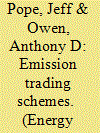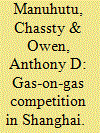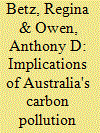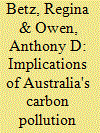|
|
|
Sort Order |
|
|
|
Items / Page
|
|
|
|
|
|
|
| Srl | Item |
| 1 |
ID:
103395


|
|
|
|
|
| Publication |
2011.
|
| Summary/Abstract |
This paper assesses the economic viability of investment in nuclear power generation in Australia in the future and, in addition, domestic factors which may influence government policy towards such investments. It argues that the structure of the grid in Eastern Australia and the nature of the existing generator mix would require nuclear technology that has similar attributes to current combined cycle gas technology; i.e. modular construction of (relatively) small generating units, load following capability, low unit capital cost, and a general acceptance by the Australian public. The current generation of nuclear plants possesses none of these attributes. Therefore this paper concludes that it is only technology with similar characteristics to some Generation IV nuclear technology concepts that has the potential to be part of Australia's energy mix after 2030.
|
|
|
|
|
|
|
|
|
|
|
|
|
|
|
|
| 2 |
ID:
092769


|
|
|
|
|
| Publication |
2009.
|
| Summary/Abstract |
The case for the imposition of carbon (emission) taxes or tradable carbon permits in important tax jurisdictions is arguably strong, based upon the polluter pays principle first proposed by Pigou almost a century ago. This paper briefly reviews the arguments for and against these market-based instruments, and discusses their relative advantages and disadvantages in a practical context. In the case of Australia, the revenue effect of the proposed tradable carbon permits scheme is estimated to be A$11.5 billion in 2010-11. For comparison, this is roughly equivalent to a quarter of the revenue from the Goods and Services Tax. The paper focuses on three neglected aspects of climate change taxation discussion to date: how much tax revenue is likely to be raised, and the administrative and compliance costs of an emissions trading scheme, with particular reference to Australia. In discussing these issues, the paper draws upon selected and relevant international experience, particularly the European Union emissions trading scheme. The challenges of an emissions trading scheme, including integration with the existing tax system, particularly in an Australian context, are also discussed. The paper concludes by emphasising the key challenges and issues facing this 'ultimate externality' debate, particularly from a taxation policy perspective.
|
|
|
|
|
|
|
|
|
|
|
|
|
|
|
|
| 3 |
ID:
094875


|
|
|
|
|
| Publication |
2010.
|
| Summary/Abstract |
In common with other major economic centres in China, Shanghai's energy consumption has been increasing rapidly to support the high growth rate of its economy. To achieve rational, efficient and clean use of energy, together with improved environmental quality within the city, the Shanghai municipal government has decided to expand the supply and utilization of natural gas. Shanghai plans to increase the share of natural gas in its primary energy mix to 7 per cent by 2010, up from 3 per cent in 2005. This increase in natural gas demand has to be matched with a corresponding increase in supply. To date, the Shanghai region has relied on offshore extracted natural gas but this supply is limited due to the size of the reserves. Since 2005, the West-East pipeline has provided an alternative for Shanghai but demands from other regions could reduce the potential for expanding supplies from that source. Since domestic production will not be sufficient to meet demand in the near future, Shanghai is building a liquefied natural gas (LNG) regasification terminal at the Yangshan deep-water port that would allow an additional supply of more than 3 billion cubic meters per year of natural gas. Malaysia has already committed to supply LNG to the Shanghai terminal at a price that is significantly higher than the wholesale "city-gate" price for natural gas transported via pipeline, but still lower than the gas price to end-use consumers. The presence of both an LNG terminal and a transmission pipeline that connects Shanghai to domestic gas-producing regions will create gas-on-gas competition. This study assesses the benefits of introducing such competition to one of China's most advanced cities under various scenarios for demand growth. In this paper, the impact of imported LNG on market concentration in Shanghai's gas market will be analysed using the Herfindahl-Hirschmann index (HHI) and the residual supply index (RSI). Our results show that Shanghai remains a supply-constrained gas market that will continue to rely upon gas supplies from the western provinces and imported LNG. After 2017, the gas market in Shanghai can be regarded as unconcentrated since its HHI fall below 1800 under a very high growth scenario. In terms of RSI, the gas market can be considered competitive at low, moderate and high growth consumption between 2012 and 2015.
|
|
|
|
|
|
|
|
|
|
|
|
|
|
|
|
| 4 |
ID:
098273


|
|
|
|
|
| Publication |
2010.
|
| Summary/Abstract |
This paper assesses the major implications for the National Electricity Market of the introduction of a domestic cap-and-trade carbon pollution reduction scheme in Australia. The electricity sector is the largest source of emissions in the Australian economy, and it is this sector, therefore, that will bear the brunt of the impact of the proposed scheme. The paper addresses core issues for the electricity market up to 2020 operating under the scheme. It focuses specifically on its impact on electricity prices and generation technology mix. These two variables have been assessed using a number of models, each applying different assumptions about key impact factors. In this paper we present a comparative summary of the results of the three highest-profile models and compare their assumptions in order to explain differences in projected outcomes. This comparison will give an indication of the likely range of impacts on the market of the current design of the scheme.
|
|
|
|
|
|
|
|
|
|
|
|
|
|
|
|
| 5 |
ID:
098581


|
|
|
|
|
| Publication |
2010.
|
| Summary/Abstract |
This paper assesses the major implications for the National Electricity Market of the introduction of a domestic cap-and-trade carbon pollution reduction scheme in Australia. The electricity sector is the largest source of emissions in the Australian economy, and it is this sector, therefore, that will bear the brunt of the impact of the proposed scheme. The paper addresses core issues for the electricity market up to 2020 operating under the scheme. It focuses specifically on its impact on electricity prices and generation technology mix. These two variables have been assessed using a number of models, each applying different assumptions about key impact factors. In this paper we present a comparative summary of the results of the three highest-profile models and compare their assumptions in order to explain differences in projected outcomes. This comparison will give an indication of the likely range of impacts on the market of the current design of the scheme.
|
|
|
|
|
|
|
|
|
|
|
|
|
|
|
|
|
|
|
|
|